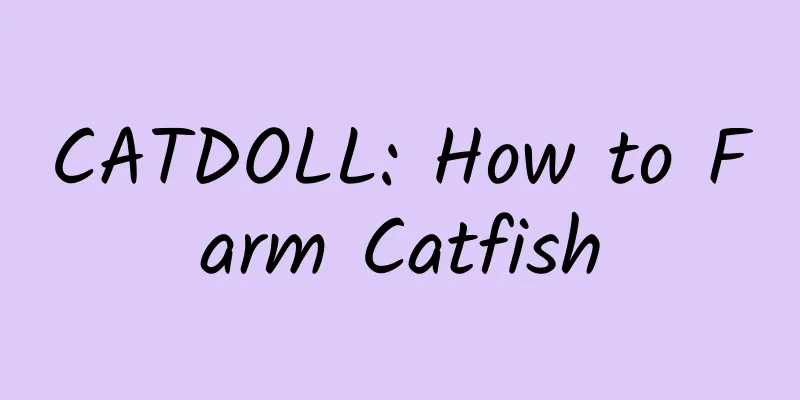CATDOLL : CATDOLL: How to Farm Catfish

|
I wonder if you raise them at home or in a pond? It is not easy to keep catfish at home because it is too big and needs a big fish tank. If it is hungry, you can feed it with loach, but catfish bought from the market are generally not good for eating. If you buy an ornamental catfish, it is easy to feed it. Just feed it with goldfish food or tropical fish food, and it does not require a very large fish tank. The specific method of raising it is the same as that of goldfish. If you are raising them in a pond, please see the following catfish pond farming techniques: Catfish (Silurus asotus) belongs to the order Siluriformes, family Siluridae, genus Silurus. Heilongjiang catfish is not only large in size and fast in growth, but also resistant to low temperatures and hypoxia, and has delicious meat, making it popular among producers and consumers in the northern high-altitude cold regions. Based on many years of practice, the author summarizes the catfish pond farming technology as follows. 1 Artificial breeding of catfish in ponds 1.1 Selection of broodstock: Choose broodstock with tail weight of more than 0.5kg. Female fish with enlarged abdomen, red and swollen genital opening, and eggs can be squeezed out by light pressure on the abdomen. Male fish with narrow abdomen can squeeze out white semen by light pressure on the abdomen. The male-female ratio is 1:1-1.5, and the individual size is appropriate. 1.2 Aphrodisiac: Catfish breeding practice has shown that after prenatal cultivation of catfish gonads to the end of stage IV, the best induced labor drug to use is a mixture of dioproton maleate (DOM) and luteinizing hormone releasing hormone A2 (LHRH?A2). The dosage is 2mg~5mgDOM+2μg~4μgLHRH?A2 per kilogram of catfish. The mixture of the two drugs is injected once into the back muscle, and the induced labor rate can reach more than 80%. 1.3 Artificial nesting: Catfish spawning attachments are arranged in the spawning pond. The method is similar to that of carp, but catfish eggs are not as sticky as carp eggs. Some eggs are easy to fall off the fish nest and fall to the bottom of the pond and die easily. In order to improve the utilization rate of catfish eggs, a bottom nest should be arranged at the bottom of the spawning ovary. The method is to weld iron rods with a diameter of 0.8 to 1 cm into a 3m×1m rectangular frame, connected in the middle with screen silk, and palm skin with eggs sewn on the screen silk. The bottom nest egg rate accounts for 20-40% of the total number of eggs laid. 1.4 Artificial hatching: After the catfish lays eggs, the ovaries should be removed and placed in the hatching pond in time to prevent the parent fish from mutilating their eggs. The hatching pond is preferably a cement pond. The bottom of the earthen pond should be flat and free of silt. The water depth should be within 0.5-1m. The area should not be too large. The density of eggs is 30,000/m2 of water surface. The water quality needs to be strictly filtered to prevent the harm of aquatic animals to fish eggs. The other hatching processes are similar to those of carp. When the water temperature is around 20℃, the membrane will break and the fry will emerge in 3-4 days. The newly emerged catfish fry will be attached to the fish nest and develop under still water or micro-flowing water conditions. They are tadpole-shaped. The fish nest should be removed in time 3 days after hatching and put into the pond in time. 2 Pond culture technology 2.1 Catfish fry ponding: Catfish can actively eat large rotifers and small cladocerans 3 to 4 days after hatching, so they should be put into the pond in time. The abundance of cladocerans after catfish fry are the key to the survival rate of catfish fry. Cladocerans are cultivated in large quantities by applying organic fertilizer. When natural bait is insufficient in the later stage, cladocerans or fresh animal bait can be scooped from other ponds with a 50-mesh screen or cut into pieces and fed. There is enough animal bait in the pond, and the catfish fry grows faster. Generally, about 90,000 catfish are put in 667m2. After 10 to 15 days of breeding, summer flowers can be grown, and the survival rate can reach 50%. The water surface of the pond for the frying is preferably within 667m2. 2.2 Fish breeding 2.2.1 Ecological breeding to cultivate catfish species: Apply a large amount of organic fertilizer to cultivate zooplankton, benthic organisms, aquatic insects and small fish, and provide catfish with nutritious animal live bait. This method has a high survival rate and large size. In 1997, 2,500 summer catfish were stocked in a 4,000m2 pond, accounting for 54.3% of the total stocking, 700 summer silver carp, accounting for 15.3% of the total stocking, and 1,400 summer bighead carp, accounting for 30.4% of the total stocking. 200 crucian carp broodstock were stocked 17 days before the stocking of catfish fry to allow them to reproduce naturally. 500kg of basal fertilizer and topdressing were applied per 667m2, and 150kg of powdered feed was fed to the crucian carp fry. After 90 days of feeding, the catfish produced an average of 50.5kg per 667m2, with a survival rate of 94.8% and a size of 128g/tail. The survival rate of silver carp is 78%, and that of bighead carp is 85%. This breeding method is simple and easy to master, and crucian carp fry are easy to obtain as bait fish. The stocking density of catfish fry should be determined by the amount of bait fish, and catfish fry can only be stocked 10 days after silver carp is stocked. 2.2.2 Catfish summer flower with fish pond: Adding less than 10% catfish summer flower in fish pond can not only remove wild fish, aquatic insects, tadpoles, etc. in the pond, but also increase the yield of the main cultured fish species and improve the efficiency of the pond. In 1995, 12.2% (500 fish/667m2) of catfish summer flower were stocked in the domesticated main carp seed pond. In 1996, 6.67% (300 fish/667m2) of catfish summer flower were stocked. Without affecting the survival rate and yield of the main fish, the catfish yield per 667m2 increased by 43.75kg (feeding part of the chicken intestines) and 16.2kg. 2.2.3 Raising catfish fingerlings in adult fish ponds: This method requires low investment, has high benefits, and does not require additional management measures. In particular, in adult fish ponds with a large number of small miscellaneous fish, 100 to 200 summer catfish can be stocked per 667m2, which can produce 10 to 20kg of catfish fingerlings weighing 100 to 150g each, increasing benefits by 200 to 200 yuan per 667m2. 2.2.4 Catfish breeding with pellet feed: Catfish grow faster and have a higher survival rate when fed with natural animal feed or terrestrial animal feed. They also eat artificial pellet feed when hungry. They can be domesticated and cultured in ponds with pellet feed. However, they have higher nutritional requirements for feed. The protein content of pellet feed in domestication is higher than that of carp. Catfish feed protein should be about 40%, and animal protein (imported fish meal) should account for more than 30% of feed protein. The processing and domestication methods of pellet feed are basically similar to those of carp. The tail weight of catfish bred by this method can reach 50-100g. In 1997, 6,000 catfish were raised in a pond of 667m2 and domesticated with pellet feed. 667m2 produced 93.5kg, the feed coefficient was 3, the average tail weight was 84.5g, and the survival rate was 18.44%. The author believes that the main reason for the low survival rate of catfish is that the bait is not palatable and the nutrition is incomplete, resulting in uneven sizes. Large individuals swallow small individuals. When the catfish weigh about 10g, they kill each other seriously, which is the main factor affecting the large-scale production of catfish. In order to improve the survival rate of catfish, some palatable animal bait should be supplemented from the beginning of summer. 2.3 Fish farming 2.3.1 Catfish are raised as commercial fish in the same year: Catfish are raised in the pond with abundant small fish. About 30 catfish are raised in 667m2. The weight can reach more than 0.35kg in the same year, and the largest individual can reach 0.75kg. The catfish production can be increased by 5-10kg in 667m2. The density can be flexibly controlled according to the water source conditions and the number of fish in the pond. 2.3.2 Catfish spring fillet fish for fish ponds: Catfish swim slowly and generally cannot prey on fast-swimming farmed fish of the same size. Stocking catfish of a certain size in a pond can only remove small wild fish and sick farmed fish in the pond. The commercial fish pond of 667m2 is stocked with 50 to 100 tail weights. Please tell me the specific situation of your catfish so that I can know how to raise it. |
<<: CATDOLL: How to farm sea cucumbers
Recommend
CATDOLL: The name of the killer bee is so scary, can this kind of bee really kill humans?
The name of the killer bee is so scary, can this ...
CATDOLL: How to control ants
1. How to prevent and control ants Burn eggshells...
CATDOLL: Tips for raising raccoon dogs in separate litters, how to feed them properly
Tips for raising raccoon dogs in separate litters...
CATDOLL: How much does a pound of golden cicada shell cost in 2022?
How much does a pound of golden cicada shell cost...
CATDOLL: Why are my fish getting smaller and smaller?
Why are my fish getting smaller and smaller? Beca...
CATDOLL: How to raise bullfrogs with fly maggots
1. How to raise bullfrogs with fly maggots In the...
What causes cat poop to stink?
Reasons why cat poop stinks: 1. If the protein co...
CATDOLL: How much profit is there in maggot farming?
1. Is it really profitable to raise fly maggots? ...
CATDOLL: How to prevent diseases when breeding Hetanghua yellow bone fish?
1. Yellow catfish is widely distributed in natura...
CATDOLL: Causes and treatments for swollen chicken eyes
Swollen eyes in chickens are a common health prob...
CATDOLL: Wang Liang from Neijiang, Sichuan, who breeds loaches, is a liar who sells wild loach fry
1. Wang Liang from Neijiang, Sichuan, who farms l...
CATDOLL: What kind of fish is the mullet?
1. What kind of fish is the mullet? Tang mullet i...
CATDOLL: What is the preparation and feeding method of bee feed?
What is the preparation and feeding method of bee...
CATDOLL: Requirements for keeping bat pomfret
A larger aquarium is required to raise this fish....
CATDOLL: Automatic silkworm rearing equipment (automatic silkworm rearing equipment video)
1. What is the main function of cloud intelligent...









